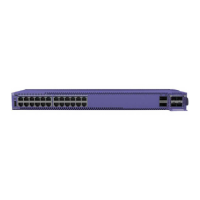that the bend radius for fiber optic cable equal at least 5 cm (2 in) for each 90-degree turn as shown in
Figure 148.
Note
Kinks and sharp bends can destroy or impair the cable’s ability to convey light pulses
accurately from one end of the cable to the other. Use care in dressing the optical fiber cables:
provide satisfactory strain relief to support the cable and maintain an adequate bend radius at
all cable turns, particularly where the cable connects to the I/O module.
Figure 148: Bend Radius for Fiber Optic Cable
1 = Minimum 5 cm (2 in) radius in 90° bend
Cable Distances and Types
Table 73 on page 172 shows one example of cable media types and maximum distances that support
reliable transmission in accordance with international standards (except where noted). Refer to Extreme
Networks Pluggable Transceivers Installation Guide for descriptions of optics and cables, as well as a
complete list of supported cable lengths.
Refer to Extreme Hardware/Software Compatibility and Recommendation Matrices for a list of the cable
types that are compatible with your equipment.
Table 73: Cable Distances and Types
Standard Media Type MHz•km
Rating
Maximum Distance
(Meters)
1000BASE-SX
(850nm optical window)
50/125 µm multimode fiber 400 500
50/125 µm multimode fiber 500 550
62.5/125 µm multimode fiber 160 220
62.5/125 µm multimode fiber 200 275
Installing Cable Site Preparation
172 ExtremeSwitching Hardware Installation Guide

